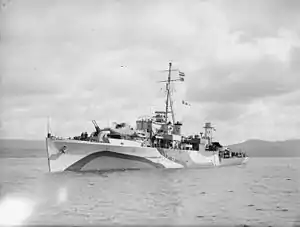HMS Crane (U23)
HMS Crane was a modified Black Swan-class sloop of the Royal Navy. She was laid down by William Denny and Brothers, Dumbarton on 13 June 1941, launched on 9 November 1942 and commissioned on 10 May 1943, with the pennant number U23.[1]
 HMS Crane at the Greenock on 6 May 1943. | |
| History | |
|---|---|
| Name: | Crane |
| Namesake: | Crane |
| Ordered: | 9 January 1941 |
| Builder: | William Denny and Brothers, Dumbarton |
| Laid down: | 13 June 1941 |
| Launched: | 9 November 1942 |
| Commissioned: | 10 May 1943 |
| Identification: | Pennant number: U23 |
| Status: | Scrapped in 1965 |
| General characteristics | |
| Class and type: | Modified Black Swan-class sloop |
| Displacement: | 1,350 tons |
| Length: | 283 ft (86 m) |
| Beam: | 38.5 ft (11.7 m) |
| Propulsion: |
|
| Speed: | 20 knots (37 km/h) at 4,300 hp (3,200 kW) |
| Complement: | 192 men + 1 Cat |
| Armament: |
|
Construction and career
HMS Crane was put into service in May 1943, she joined sloops HMS Chanticleer and HMS Pheasant in 7th Escort Group at Greenock for the escort and support of military convoys from the Atlantic to Gibraltar, as well as military convoys in the Mediterranean for Operation Husky.
In September 1943, she was deployed with the 1st support group for joint anti-submarine operations with RAF Coastal Command in the Bay of Biscay against U-Boote submarines during the passage to and from bases in France.
On 21 November 1943 the submarine U-538 was sunk in the North Atlantic south-west of Ireland by depth charges of the HMS Foley and HMS Crane.
HMS Crane accompanied by HMS Cygnet, sank the German submarine U-962 on 8 April 1944 in the North Atlantic northwest of Cape Finisterre by depth charges.
In May 1944, he was transferred to the English Channel to support the allies planned for the Normandy landings for Operation Neptune.
From September to October 1944, she was in repairs after her involvement in a collision with the merchant steamer SS Tilapia while sustaining structural damage. At the end of the work, she was transferred for service with the British Pacific Fleet.
She remained until the end of the war in the protection of convoys in the Pacific.
HMS Crane remained with the British Pacific Fleet after the surrender of Japan and was deployed on a Hong Kong-based patrol until refit to Brisbane, Australia in late 1945.
Once completed, the ship was assigned to the 3rd Frigate Flotilla until July 1946, when it returned to the United Kingdom. Upon arrival after being disarmed, it is reduced to reserve status in Harwich. Later transferred to the Chatham Reserve Fleet and in July 1951 advanced to serve with the 3rd Frigate Flotilla in the Far East.
It was returned to service after a refit during which the Hedgehog anti-submarine mortar equipment was installed and the 20mm Oerlikon weapons replaced by 40mm Bofors. Apart from the detachment to the Mediterranean during the Suez crisis in 1956, she remained in the Far East until 1962. During the Suez Canal crisis, HMS Crane was damaged by Israeli planes.
This ship was finally deactivated at the end of 1962 and dropped off at Portsmouth. When he entered the demolition list in 1965, it was sold to BISCO to be dismantled by Lacmots in Queenborough, Kent, where it arrived in March of the same year.[2]
References
- "HMS Crane (U 23) of the Royal Navy - British Sloop of the Modified Black Swan class - Allied Warships of WWII - uboat.net". uboat.net. Retrieved 20 October 2020.
- "HMS Crane, sloop". www.naval-history.net. Retrieved 20 October 2020.
Further readings
- Blackman, Raymond V. B. (1971). Jane's Fighting Ships 1971–72. London: Sampson Low, Marston & Company. ISBN 0-354-00096-9.
- Blair, Clay Gardiner (2000). Hitler's U-Boat War: The Hunted 1942–1945. Vol. 3. New York: Modern Library. ISBN 0-679-64033-9.
- Gardiner, Robert Gardiner (1980). Conway's All the World's Fighting Ships (1922-1946). Vol. 3. Conway Maritime Press. p. 456. ISBN 0-85177-146-7.
- Gardiner, Robert Gardiner (1996). Conway's All the World's Fighting Ships (1947-1995). Vol. 4. US Naval Institute Press. p. 675. ISBN 1-55750-132-7.
- Colledge, J. J.; Warlow, Ben (2006) [1969]. Ships of the Royal Navy: The Complete Record of all Fighting Ships of the Royal Navy (Rev. ed.). London: Chatham Publishing. ISBN 978-1-86176-281-8.
- Hague, Arnold (1993). Sloops: A History of the 71 Sloops Built in Britain and Australia for the British, Australian and Indian Navies 1926–1946. Kendal, England: World Ship Society. ISBN 0-905617-67-3.